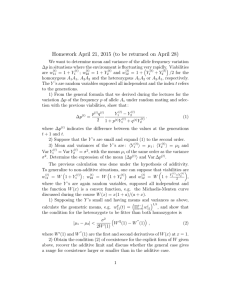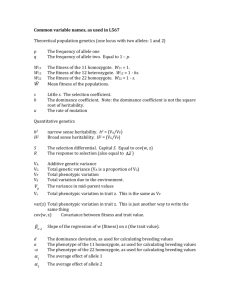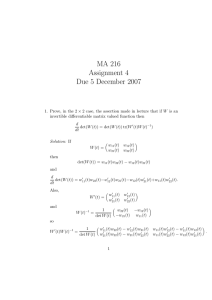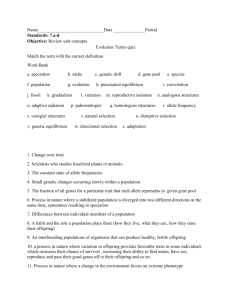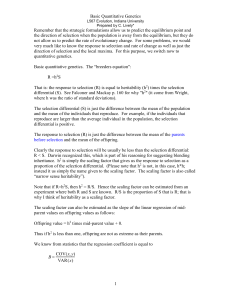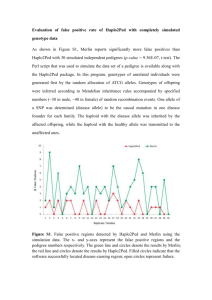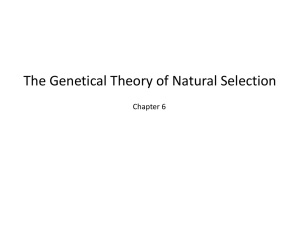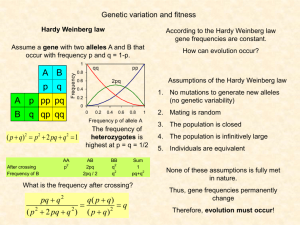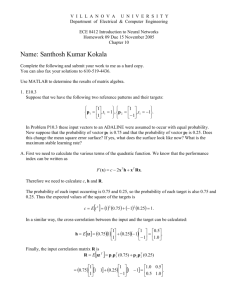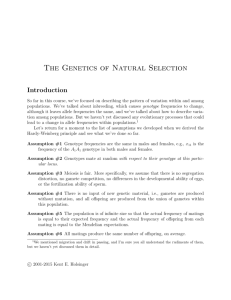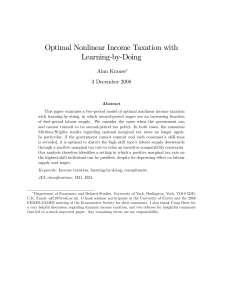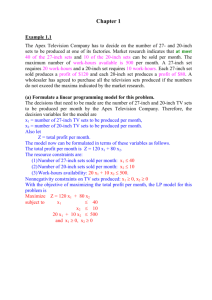L567 lecture 3, 5 September, 2006
advertisement
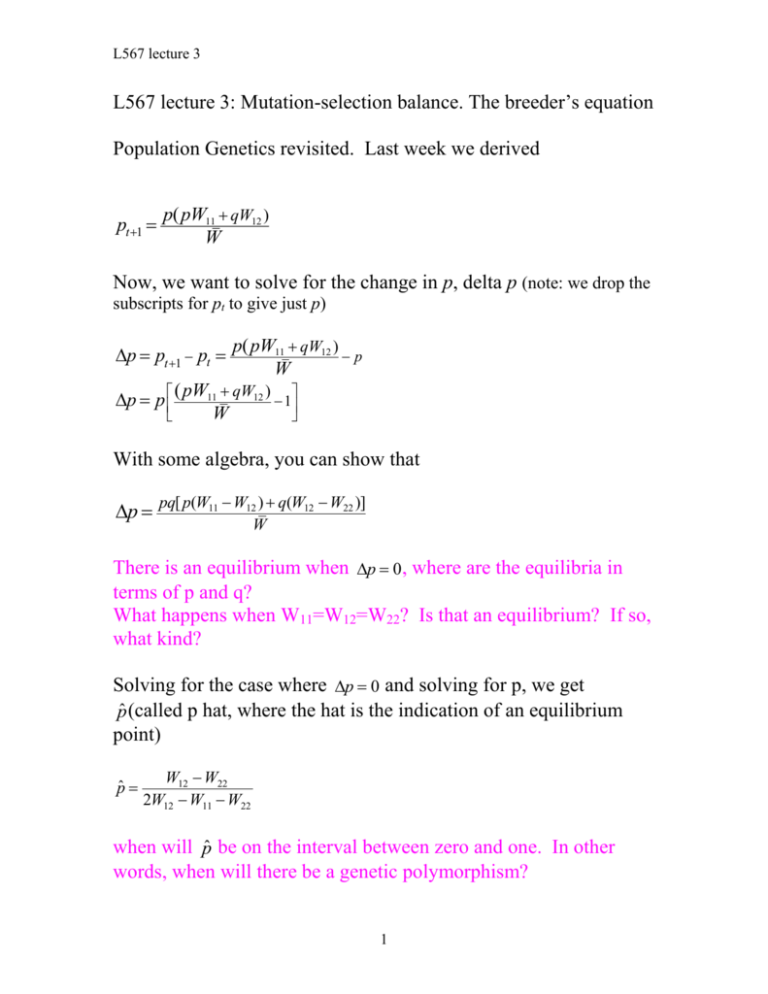
L567 lecture 3 L567 lecture 3: Mutation-selection balance. The breeder’s equation Population Genetics revisited. Last week we derived pt+1 = p(pW11 + qW12 ) W Now, we want to solve for the change in p, delta p (note: we drop the subscripts for pt to give just p) Dp = pt+1 - pt = p(pW11 + qW12 ) -p W (pW11 + qW12 ) ù - 1ú W ë û Dp = p éê With some algebra, you can show that Dp = pq[ p(W11 - W12 ) + q(W12 - W22 )] W There is an equilibrium when Dp = 0, where are the equilibria in terms of p and q? What happens when W11=W12=W22? Is that an equilibrium? If so, what kind? Solving for the case where Dp = 0 and solving for p, we get p̂ (called p hat, where the hat is the indication of an equilibrium point) p̂ = W12 - W22 2W12 - W11 - W22 when will p̂ be on the interval between zero and one. In other words, when will there be a genetic polymorphism? 1 L567 lecture 3 Finally, the main point. Natural selection can cause gradual change in gene frequencies (and hence gradual phenotypic change), even when selection is weak. This simple model helped to solve the conflict between the Mendelians and the Biometricians. Tweak number 2 Remember that Dp = pq[ p(W11 - W12 ) + q(W12 - W22 )] W Now let, W11 = 1 W12 = 1- hs W22 = 1- s where h is the dominance coefficient, and s (little s) is the selection coefficient. If h=1, which allele is dominant? If h=0, which allele is dominant? What happens when h=0.5 (we call this co-dominance)? If we assume that s is small, then Wbar is approximately equal to one. (Convince yourself of this.) 2 L567 lecture 3 Under this assumption, we get Dp » pq[ p(1- (1- hs)) + q((1- hs) - (1- s))] 1 Dp » pqs[ ph + q(1- h)] So, very clearly, delta p depends on allele frequencies, the strength of selection, and dominance. If allele 1 is a favored dominant (h=0), what is delta p? If allele 1 is a favored recessive (h=1), what is delta p? Assuming allele 1 is rare (p close to zero), what difference does it make to the initial rate of change, delta p? Now, modify your excel file to iterate Dp = pq[ p(W11 - W12 ) + q(W12 - W22 )] W for W11 = 1 W12 = 1- hs W22 = 1- s Graph the results for s=0.1, and h = 0, 0.5 and 1. You will need to extend the number of generations to about 1200. Finally, modify the model so that the heterozygotes are most fit (W12= 1; W11<1 and W22<1). You should get a stable polymorphism 3 L567 lecture 3 You can also get a stable polymorphism when there is a balance between natural selection and mutation. Let u be the mutation rate from allele 1 to allele 2. Assume that that mutation rate from allele 2 to allele 1 is zero. With this new tweak, we have pt +1 = p(pW11 + qW12 )(1- u) W Let’s assume that allele 1 is dominant (h=0) and favored by selection. Hence it should go virtually to fixation (in a infinite population) in the absence of any opposing force, like mutation. Specifically, let’s assume that: W11 = 1 W12 = 1 W22 = 1- s At equilibrium, pt +1 - p = 0 . Solving for this equilbrium, you can show that 1- p̂ = q̂ = u . s Hence for u>0, allele 2 is maintained by a balance between natural selection and mutation. Verify this using your excel simulation. Do you think the results are reasonably robust to the assumption of no mutation for allele 2 to 1 (at least for the present scenario)? 4 L567 lecture 3 Basic quantitative genetics. The “breeders equation": R = h2S That is: the response to selection (R) is equal to heritability (h2) times the selection differential (S). See Falconer and Mackay p. 160 for why "h2" (it comes from Wright, where h was the ratio of standard deviations). Note the similarity between the breeder’s equation and the syllogism given in lecture 1. The selection differential (S) is just the difference between the mean of the population and the mean of the individuals that reproduce. Note caps (big S). S is not the same as s (the selection coefficient in population genetics. The response to selection (R) is just the difference between the mean of the parents before selection and the mean of the offspring. (Draw in graphs for R and S below) 5 L567 lecture 3 Clearly the response to selection will be less than the selection differential: R < S. Darwin recognized this, which is part of his reasoning for suggesting blending inheritance. h2 is simply the scaling factor that gives us the response to selection as a proportion of the selection differential. (Please note that h2 is not, in this case, h*h; instead it us simply the name given to the scaling factor. The scaling factor is also called “narrow sense heritability”). The scaling factor can be estimated as the slope of the linear regression of mid-parent values on offspring values as follows: Offspring value = h2 * mid-parent value + c. Thus if h2 is less than one, offspring are not as extreme as their parents, and R<S. (Draw in graphs for h2 = 1 and h2 <1 below) 6 L567 lecture 3 Note that if R=h2S, then h2 = R/S. Hence the scaling factor can also be estimated from an experiment where both R and S are known. R/S is the proportion of S that is R; that is why I think of heritability as a scaling factor. We know from statistics that the regression coefficient is equal to B= COV(x, y) VAR(x) For our purposes then: h2 = COV(p , o) , VAR(p) which in words simply means the covariation between mid-parent values and offspring values, divided by the total variation in the mid-parent values. Covariation between parents and offspring, COV(p,o), measures the extent to which deviations from the mean in the parents are reflected in deviations in their mean in the offspring. If COV(p,o) is positive, the deviations are correlated and in the same direction. In other words, estimation of covariance answers this question: do parents that are larger than the mean for their generation produce offspring that are larger than the mean in their generation? And, similarly, do parents that are smaller than the mean for their generation produce offspring that are smaller than the mean in their generation? 7 L567 lecture 3 Now, and this is key: the COV(p,o) is also an estimate of half the "additive genetic 1 variation": or COV(p,o) = VA . 2 And VAR(p) is equal to one half VP, the total variance among 1 parents (or the total phenotypic variance): VAR(p) = Vp . 2 Hence: h = 2 COV(p , o) 0.5VA VA = = VAR(p) 0.5Vp Vp So heritability can also be expressed as h2 = VA , VP the ratio of additive genetic variation to total phenotypic variation. So the scaling factor is determined by the amount of additive genetic variation relative to the total amount of phenotypic variation. Question: when would evolution by natural selection stop happening in a QG model? Finally, the selection differential, S, can also be estimated as S= COV(phenotype, relative fitness)=cov(z, w), where w is the relative fitness = W / W , and z is the trait value (See Lynch and Walsh, page 46). Alternatively, S= cov(Wi , zi ) , W where Wi is the number of offspring produced (absolute fitness) (see Rice, page 193). *Mostly taken from Lynch and Walsh, pages 45-50, and Falconer and MacKay 125-127. 8
